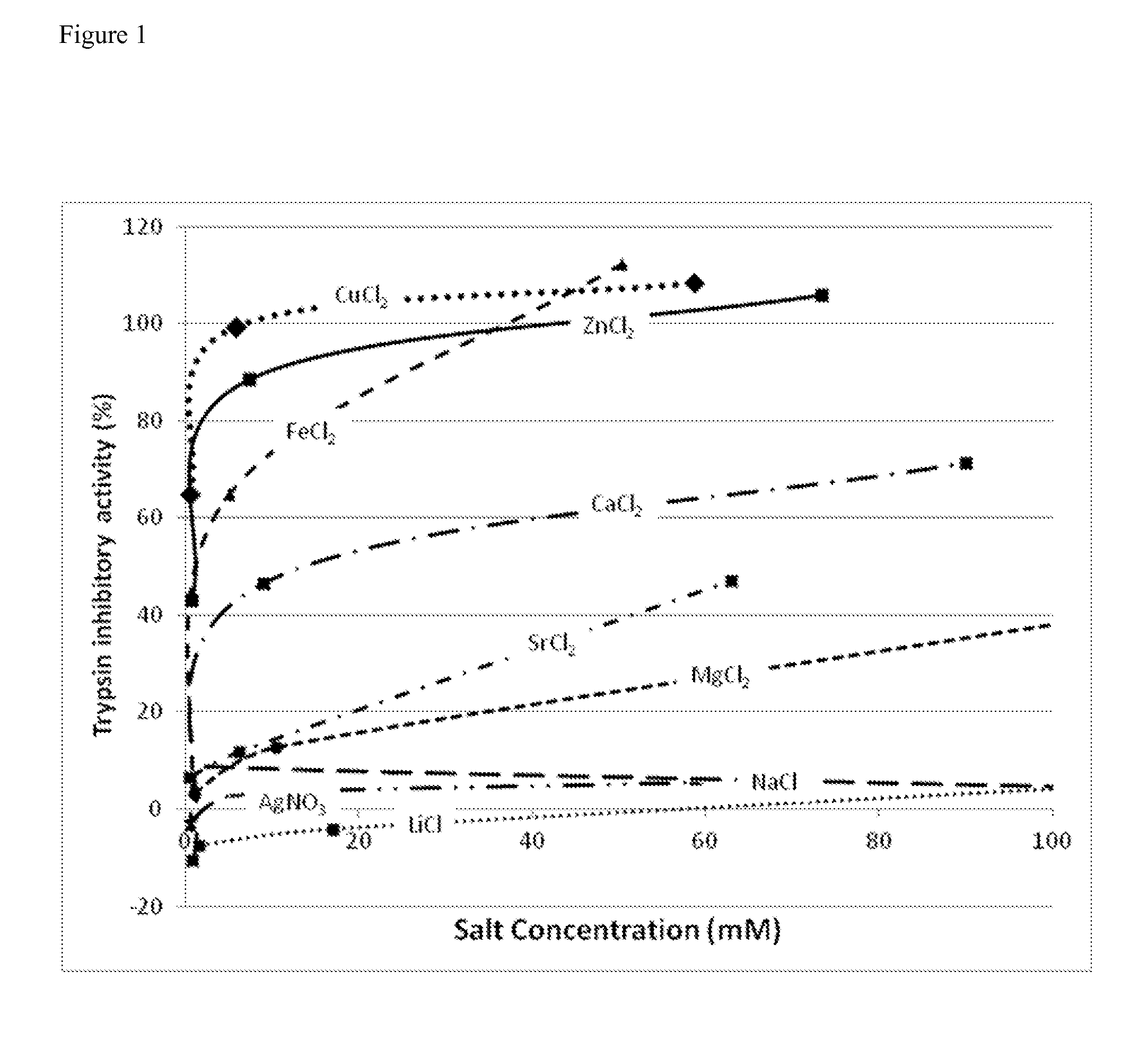Divalent cation/talc containing compositions and methods for treating and/or preventing enzymatic irritation
a technology of divalent cation and talc, which is applied in the direction of drug compositions, biocide, dermatological disorders, etc., can solve the problems of diaper rash, skin inflammatory events, and skin barrier function being compromised, and is commonly known as diaper rash
- Summary
- Abstract
- Description
- Claims
- Application Information
AI Technical Summary
Benefits of technology
Problems solved by technology
Method used
Image
Examples
example 1
The Effect of Cations on Trypsin Inhibition
[0078]The objective of the following experiment was to determine whether and to what extent the following cations inhibited trypsin activity in an in vitro assay.
[0079]The inhibition of trypsin-induced cleavage of a fluorescent casein peptide was measured using the EnzChek™ protease assay kit, following manufacturer's instructions (EnzChek™ Protease Assay Kits Product Information, Revised; Molecular Probes, Eugene Oreg.). Briefly, test materials at different concentrations were prepared in 1× phosphate buffered saline (PBS, pH 7.4). Trypsin working solution (Sigma, St. Louis, Mo., unit / mL) was prepared in digestion buffer provided in the assay kit. Stock solution of BODIPY FL casein (trypsin substrate, mg / mL) was prepared by adding 0.2 mL to the substrate vials (provided in kit), and the final substrate working solution (10 microgram / mL) was prepared by dilution in digestion buffer (pH 7.8). Following incubation of trypsin, with or without ...
example 2
The Effect of Salt Form of the Same Divalent Cation on Trypsin Inhibition
[0080]The objective of the following experiment was to determine whether and to what extent different salt forms of the same divalent cation had on inhibition of trypsin activity in an in vitro assay.
[0081]Trypsin inhibitory activity was analyzed as described in Example 1 and the effect of different salt forms of the same cations on the trypsin inhibitory activities was assessed. Table 2 shows the molecular weights, concentration and trypsin inhibitory activity of tested compounds.
TABLE 2% trypsinMolecular% weightinhibitoryChemical nameMolecular formulaweight(g / mL)mMactivityZinc chlorideZnCl2136.320.01%0.7341.250.10%7.3487.69 1%73.3698.75Zinc acetateZn(C2H3O2)2•(H2O)2219.50.01%0.4636.22dihydrate0.10%4.5668.92 1%45.5693.8Zinc gluconateZn(C6H11O7)2455.680.01%0.2225.330.10%2.1940.93 1%21.9485.52Zinc lactateZn(C6H11O7)2243.550.01%0.4123.010.10%4.1136.36 1%41.0687.95Copper (II)Cu(C2H3O2)2•(H2O)199.650.01%0.5066....
example 3
[0083]The objective of the following experiment was to determine whether and to what extent adding a divalent cation to talc inhibited trypsin activity in an in vitro assay. The inhibition of trypsin-induced cleavage of a fluorescent casein peptide was measured using the EnzChek™ protease assay kit, following manufacturer's instructions (EnzChek™ Protease Assay Kits Product Information, Revised; Molecular Probes, Eugene Oreg.). Briefly, mixtures of talc stock solutions with (1) divalent cation salts at different concentrations (as indicated in Table 3) and (2) magnesium chloride at different concentrations (as indicated in Table 4) were prepared in 1× phosphate buffered saline (PBS, pH 7.4). Trypsin working solution (Sigma, St. Louis, Mo., unit / mL) was prepared in digestion buffer provided in the assay kit. Stock solution of BODIPY FL casein (trypsin substrate, mg / mL) was prepared by adding 0.2 mL to the substrate vials (provided in kit), and the final substrate working solution (10...
PUM
| Property | Measurement | Unit |
|---|---|---|
| pH | aaaaa | aaaaa |
| pH | aaaaa | aaaaa |
| composition | aaaaa | aaaaa |
Abstract
Description
Claims
Application Information
 Login to View More
Login to View More - R&D
- Intellectual Property
- Life Sciences
- Materials
- Tech Scout
- Unparalleled Data Quality
- Higher Quality Content
- 60% Fewer Hallucinations
Browse by: Latest US Patents, China's latest patents, Technical Efficacy Thesaurus, Application Domain, Technology Topic, Popular Technical Reports.
© 2025 PatSnap. All rights reserved.Legal|Privacy policy|Modern Slavery Act Transparency Statement|Sitemap|About US| Contact US: help@patsnap.com



